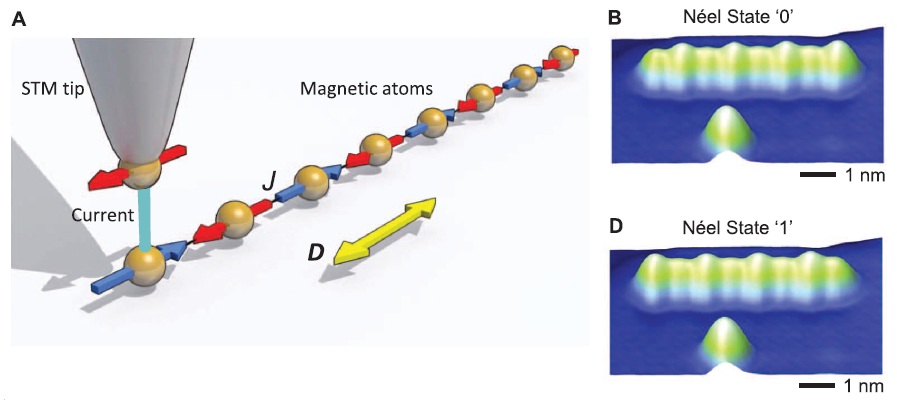
Information stored by a chain of magnetic atoms. Left: an STM tip measures the magnetic state of the iron atoms. Right: through increasing the current between tip and atoms the magnetic states can be switched. Peaks become valleys and vice versa. (c) Science Magazine
I now finally got the time to follow-up on last week’s paper in Science by Andreas Heinrich‘s group at IBM on magnetic storage elements that are only a few atoms in size. There have been a few misconceptions in some of the news reports with some being plainly wrong (‘smallest storage device ever made’), and many didn’t mention much about the scientific principles behind this study, although these are quite interesting. One of the better reports appeared in the New York Times, albeit again without going much into details. So I hope I can still add something useful with this blog post.
And actually, we’ve come across Andreas Heinrich’s previous research before, he does very innovative research with scanning tunneling microscopes (STM). In this latest Science paper he has now explored the limits of magnetic storage devices. Magnetism is of course the basis for storage such as magnetic hard drives. The problem in increasing the storage density in any magnetic storage device is that the magnetic regions begin to interfere with each other as they become smaller and are integrated closer together, because magnetic states on the order of just a couple of atoms are not very stable. […]
Continue reading...
Scanning tunnelling microscopes (STM) are a wonderful instruments that can not only image but also manipulate individual atoms on a surface. Developed by Gerd Binning and Heinrich Rohrer in 1981, STM and their derivatives revolutionized our understanding of what happens on the surface of materials.

The famous quantum corral, fabricated and imaged in 1993 by Don Eigler at IBM. Atoms (blue) are placed on a circle and consequently modify the electron density on the surface (red ripples). (c) IBM
Expanding on Binning and Rohrer’s work at IBM in Zurich, Don Eigler at IBM’s Almaden lab in particular pioneered the modification of individual atoms on a surface. In 1989 he famously accomplished moving atoms on a surface to form the letters IBM. For these accomplishments Eigler received this year’s Kavli Prize in Nanoscience.
IBM continues to pioneer STM research at Almaden. The group of Andreas Heinrich, for example, who started at IBM in 1998 as a postdoc with Don Eigler, is working on the study of magnetic atoms. He and Eigler have now accomplished another major advance in microscopy technology. So far, STM measurements were mainly static and little information of dynamic properties was available. In a study published in Science, they now have developed a method that is able to measure how long it takes for atoms to flip their electron spin. This technique opens the door to measurements of the dynamics of a number of properties, for example vibrational states.
[…]
Continue reading...




January 15, 2012
3 Comments